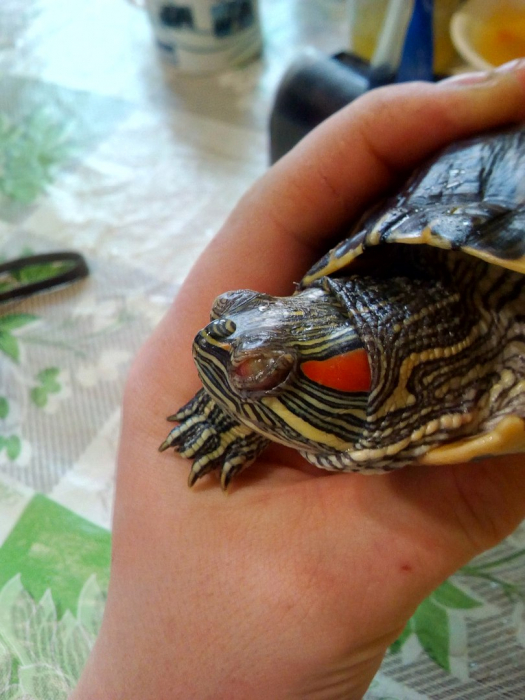Eye diseases in red-eared turtles are not uncommon. Violations can be infectious and non-infectious in nature.
Material Content:
Eye inflammation (conjunctivitis)
Often the cause of this disorder is highly chlorinated or dirty water in the aquarium, as well as a lack of vitamin A in the body of the reptile. It is manifested by a lack of appetite, which leads to exhaustion and increases the risk of developing renal failure, yellowish secretions that accumulate under the lower eyelid. They look like pus, but, in fact, they are not. The animal can rub its face with its paws. And if there is eyelid edema, and the turtle does not open its eyes, the disease is classified as blepharoconjunctivitis (the second name is marginal blepharitis).

Treatment scheme:
- Eye rinse with Ringer's solution or boric acid 3% 3-4 times a day until the symptoms disappear.
- Vitamin injections intramuscularly. The procedure is carried out once, if necessary, repeat after 2 weeks.
- Instillation of Sofradex under the lower eyelid for 7 days. Within half an hour after the administration of the medicine, the turtle must not be immersed in water.
- Eye treatment with hydrocortisone ointment 2-3 times a day for 5 days.
- If improvement does not occur, antibacterial drops, for example, Decamethoxin 1%, are indicated. The number of procedures and the duration of the course is determined by a specialist.
In order to prevent eye inflammation, products with a high carotene content should be given to the red-eared turtle and water should be changed regularly.
Uveitis and panophthalmitis
These conditions are characterized by inflammatory processes that can invade various tissues of the eye.With uveitis, the disease affects the anterior chamber of the uveal tract, and with panophthalmitis, all the membranes of the visual organ. Disorders develop as a complication of septic pneumonia or as a result of severe hypothermia. And the cause may be pathogenic bacteria that have penetrated from the oral cavity into the corneal space through the lacrimal canal.
With uveitis, the eye maintains integrity, but pus accumulates under the eyelids. As a rule, inflammation develops bilaterally. In addition, the condition may be accompanied by impaired appetite, exhaustion, rhinitis and lethargy.

Panophthalmitis manifests itself as a sharp swelling of the eyelids and densification of the tissues of the visual organ. The turtle's eye becomes like a dense granule filled with pus, with opacities in the center.
The treatment of these diseases is carried out surgically, and eye washings and antibiotics are also indicated. The selection of drugs and the treatment regimen are determined individually.
Corneal Disease
The causes of disorders of this group are injuries of the organs of vision, infectious lesions of the conjunctiva. They are manifested by clouding of the cornea, as well as pericorneal injection of the vessels of the eyeball (the appearance of a pronounced vascular network on the eye protein).
As a treatment, veterinarians prescribe local drugs in the form of drops. The specialist selects a remedy depending on the nature and characteristics of the disease.
Note. Some diseases associated with dysfunction of the cornea arise as a result of age-related changes in older individuals. One of them is senile cataract. But in Russia, one can hardly find specialists who would successfully treat her.
Optic neuropathy
This disorder is most often temporary and occurs due to thiaminases (enzymes that destroy vitamin B1), which are found in some varieties of feed.
Neuropathy is both unilateral and bilateral. It is manifested by the retraction and immobility of the eyeball and the narrowing of the pupil. The eyelids of a reptile are usually omitted.
Therapy for the disease includes injections of thiamine chloride or bromide. The scheme is determined by a specialist.
Mechanical injuries
You can understand that the tortoise’s eye is damaged by the presence of blood in it. As part of the treatment, Sofradex and Emoxipine 1% drops are used twice a day. The course of therapy with the first drug is 3 days, the second - a week. Moreover, it is possible to instill Emoxipin no earlier than an hour after Sofradex.
Ophthalmic Disease Prevention
Correct and comfortable living conditions for the Red-eared Turtle are the basis for the prevention of many diseases, including eye diseases.
- It is especially important to observe hygiene and temperature conditions to prevent infection. This will require: special lamps (including ultraviolet), a water heater and water filters (preferably external so that the animal could not damage them). The temperature of the water in the aquaterrarium should be between 23-28 degrees. And its volume is not less than 100 liters (for an adult reptile).
- Owners should pay due attention to pet feeding: the diet should have enough vitamins, especially carotene.
- Timely treatment in a veterinary clinic will help to cope with the disease faster and, possibly, to avoid more serious consequences.
If the eyes of a red-eared turtle are swollen, the eyelids are dropping, discharge has appeared - this is an occasion for an immediate visit to a herpetologist (reptile specialist) or a general veterinarian.












